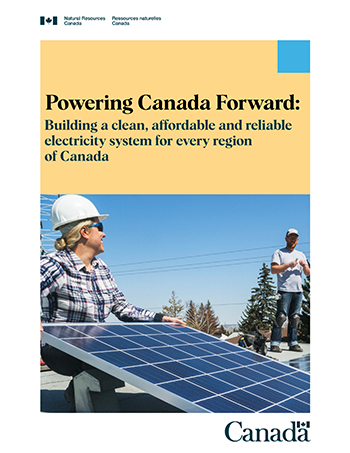Update:
Following on the next steps laid out in the “What’s next” section of the Powering Canada Forward paper, the Government of Canada released its Clean Electricity Strategy in December 2024.
On this page:
- Foreword from Ministers Guilbeault and Wilkinson
- Introduction
- Why clean electricity
- Where are we now
- What is the Federal role
- What’s next
- Conclusion
Foreword from Ministers Guilbeault and Wilkinson
Building a net-zero economy is the greatest economic opportunity of our time. The potential of hydrogen, renewables, nuclear, biofuels, critical minerals, batteries, electric vehicles, green steel and aluminum, decarbonizing conventional energy resources and more, draw on Canada’s tremendous advantages and can attract investments and create jobs and economic prosperity in every region of Canada for decades to come. Enormous economic opportunities exist for countries, provinces/territories, and companies that are strategic and bold.
Building a net-zero economy is also a scientific and moral imperative. Climate scientists are unequivocally telling us that we must drastically reduce our emissions by 2030 and achieve net-zero by 2050 if we are to leave a habitable world to our children.
The Government of Canada is steadfast in its commitment to achieve its emissions-reduction targets under the Paris Agreement. It is good for the economy and for the environment.
This means working with our partners in Canada to build clean, reliable, and affordable electricity systems across the country.
As more and more Canadians plug in electric vehicles and ride electrified public transit, and as more and more homeowners switch to electric heat pumps, the clean power they need must be there for them—when they need it, and where they need it. And we must be able to do the same for companies looking to grow and decarbonize their warehouses, offices, factories, and work sites, while also accounting for the carbon embedded in their products, so that we can be the world’s supplier of choice for such essential products as green steel and aluminum.
Canada’s electricity systems will be the backbone of Canada’s net-zero economy, and that is why we are working with provinces, territories, Indigenous partners, and others to build them by 2035—a timeline informed by both climate ambition and Canada’s commitment to its G7 partners. Indeed, being able to provide non-emitting power to industry is increasingly the “price of entry” for marketing products internationally—as we saw with the announcement of the General Motors and South Korean POSCO Future M electric vehicle battery component plant in Bécancour, Quebec.
By fully decarbonizing our electricity grids by 2035, we are enabling the rest of the economy to electrify by 2050. Luckily, we are already ahead of much of the world: our power grid is over 80% non-emitting. But there is much more work to be done.
And while we recognize that electricity is clearly an area of provincial and territorial jurisdiction, the federal government still has a critical role to play with its regulatory powers over interprovincial power lines, nuclear power, and electricity exports, as well as our shared jurisdiction on environmental regulations. The scale of the challenges—and of the opportunities—before us is simply too great for any one level of government to tackle alone. A net-zero electricity sector is so fundamentally critical to realizing our climate commitments that it merits our full collaboration.
Enabling the building of grids across the country that are reliable, affordable, and non-emitting, at the pace and scale necessary, is an enormous undertaking—a nation-building project of unprecedented scale and importance in our history. And it must be done in a way that respects provinces’ and territories’ jurisdiction and advances the self-determination of Indigenous communities.
That is why the Government of Canada is publishing this vision for a clean, affordable, and reliable electricity system for every region of Canada as a call to action to help advance a discussion—among provinces and territories, Indigenous partners, industry and labour, environmental organizations, and civil society—about how to build a clean, reliable, and affordable electricity grid from coast to coast to coast. It recognizes that no one player can make this transition happen on their own. We need each other. And so, this paper is intended to help bring together provinces, territories, Indigenous leaders, utilities and industry, the private and financial sectors, unions, academics, and civil society in this historic endeavour.
Canada has already made extraordinary progress in transforming the electricity sector due to many concrete steps taken by all levels of government. A case in point is the phasing out of coal-fired power generation in Ontario, and soon in Alberta. This paper outlines the significant work done to date by the federal government, which complements the extraordinary progress made by other levels of government to transform the electricity sector; addresses the important balance of incentives, investments, and regulations needed to ensure success; and lays the groundwork for Canada’s first Clean Electricity Strategy in 2024.
Ultimately, focusing on establishing a grid that can supply needed electricity in a manner that is affordable, reliable, and non-emitting is a crucial step in Canada’s efforts to grow the economy, make life more affordable, and protect the environment. If we get this right, we will create jobs for Canadians, ensure long-term prosperity for communities, and leave a healthier planet for our children.
So, we need to get to work. Let us collectively and collaboratively build a clean, reliable, and affordable grid across this country—together.
Steven Guilbeault, Minister of Environment and Climate Change
Jonathan Wilkinson, Minister of Energy and Natural Resources
Introduction
Climate change is the most pressing environmental challenge of our generation, but if tackled appropriately, it could also present the greatest economic opportunity of our lifetime. Nowhere is that urgency, or potential, more evident than in the greening and modernization of Canada’s electricity grids. Abundant, affordable, clean electricity is a multi-trillion-dollar market that is fundamental to building a global low-carbon economy.
Canada is ideally positioned to lead the way. We already boast one of the cleanest electricity mixes in the world. Our grids draw more than 80 percent of their power from renewable and non-emitting sources, including the world’s fourth-largest production of hydroelectricity. We’re also a Tier 1 nuclear nation and a recognized leader in hydrogen and fuel-cell technologies, while wind and solar energy are the fastest-growing sources of electricity in Canada.
In short, energy is part of our national DNA. We have what it takes to be a supplier of choice as global demand for clean electricity grows exponentially. But past achievements are no guarantee of future success—particularly amid some of the gathering headwinds, which will be discussed later. If Canada is to seize the sizable investments and well-paying jobs of a clean energy future, we must be visionary in our ambition.
Powering Canada Forward: Building a Clean, Affordable, and Reliable Electricity System for Every Region of Canada seeks to harness the unprecedented opportunities of a net-zero grid by mobilizing a national effort that would rival the building of our railway in the 19th Century—and be just as monumental an undertaking. For some provinces and territories, this could be the most daunting—and expensive—challenge to achieving net-zero emissions. The federal government is well aware of the scale of what it is requesting. Building net-zero electricity systems that would dwarf the size of our existing grids would require significant investments, co-operation, and determination.
This paper seeks to advance that effort, which is an important milestone in the Government of Canada’s commitment to decarbonizing the country’s electricity systems, as it:
- reiterates why the expansion of a clean electricity system is important and necessary to drive sustainable growth, enhance environmental performance, and advance Indigenous reconciliation;
- highlights the extensive work governments and partners have already done to create a dynamic, sustainable electricity sector; and
- outlines how the federal government has and will continue to support, incentivize, and accelerate the production of clean and non-emitting electricity.
While provinces and territories are responsible for electricity generation and delivery infrastructure within their borders, the federal government has an important role to play through its ability to convene partners and coordinate efforts while also attracting new investments, developing effective regulations, and advancing targeted approaches—all the while ensuring its contributions are responsive to the unique circumstances and opportunities in every region of the country.
The Government of Canada is committed to getting its critical work right as it develops a Clean Electricity Strategy for release in 2024. That is why this paper invites broad public participation in the federal government’s various ongoing consultations and engagement. See section titled “What’s Next” for more details on how to provide your views.
No one can undertake such a massive effort on their own. It demands the insights and input of all levels of governments, as well as the country’s leading experts—including utilities and industry, investors and financiers, unions and workers, and not-for-profits and academics. And it will need the support of Canadians from coast to coast to coast.
As electricity systems across the country expand and decarbonize, we need to work together to not only lower emissions but also to ensure that our grids are reliable and affordable. Some electricity producers are already leading the way by growing their non-emitting power-generation capacity; considering new transmission lines within and between Canada’s provinces and territories; and implementing demand-side management and distributed energy resources. All these actions are needed, but we must also remain mindful of how ratepayers and taxpayers bear the costs of this essential evolution in Canada’s electricity systems.
This paper takes stock of where we are today and encourages Canadians to think about where we want to be tomorrow. By establishing a common understanding and coordinating actions, we can transform Canada’s electricity sector to create the prosperity we all want while protecting this planet we all cherish.
Canada needs a Canadian electricity strategy to coordinate funding and building infrastructure projects across Canada and to work with the electricity sector to implement the planning and building process.Footnote 1
Why clean electricity
Positioning Canada for Success in a Global Economy
Electricity is central to our everyday lives and the backbone of our economy. From keeping the lights on in our homes, schools, and hospitals to powering businesses and key infrastructure, it is difficult to imagine any nation in the 21st century thriving without a secure, competitively priced supply of electricity. What’s more, our reliance on electricity is poised to grow dramatically as the preferred source of energy for everything from transportation and construction to manufacturing and heavy industry. Electric vehicles will soon be what the gasoline-powered automobile was to the horse-drawn buggy. Heat pumps will become the common, efficient alternative to oil furnaces. And electric arc furnaces will replace traditional coal-fired methods for producing steel.
Both now and in the future, the electricity sector’s ability to provide clean, reliable, and affordable electricity is a key enabler of Canada’s prosperity. It is a foundation for rapid electrification and an advantage for attracting foreign direct investments where a clean electricity grid is a “must have.” This means jurisdictions with clean grids will have a competitive advantage in attracting projects and investments. This is especially important in highly competitive and emerging global markets such as clean hydrogen, green steel, potash and aluminum, or zero-emission vehicles and batteries, where companies need to account more stringently for their carbon.
Volkswagen picked Canada over the United States because of our “high” standards for environmental, social, and corporate governance and picked Ontario over Oklahoma because that province has a more decarbonized power grid. EverWind Fuels plans to invest $1 billion in renewable energy generation to power its green hydrogen and ammonia production project in Nova Scotia. Recognizing the value of ESG, Algoma Steel chooses to produce green steel. Similarly, Rio Tinto is decarbonizing supply chains and operations by expanding its low-carbon aluminum production facilities in Canada.
The Canada Energy Regulator recently quantified what this increased demand for electricity could mean. Using the Global Net-Zero ScenarioFootnote 2 in its Canada’s Energy Future 2023 report, the national energy regulator predicts that we will need to more than double our current electricity production to meet residential, commercial, and industrial consumption requirements in 2050. Electric vehicles and the production of hydrogen will be among the leading sources of this new demand, alongside sustained growth in electricity use in residential, commercial, and industrial sectors.
Figure 1. Electricity use by sector, Global Net-zero Scenario
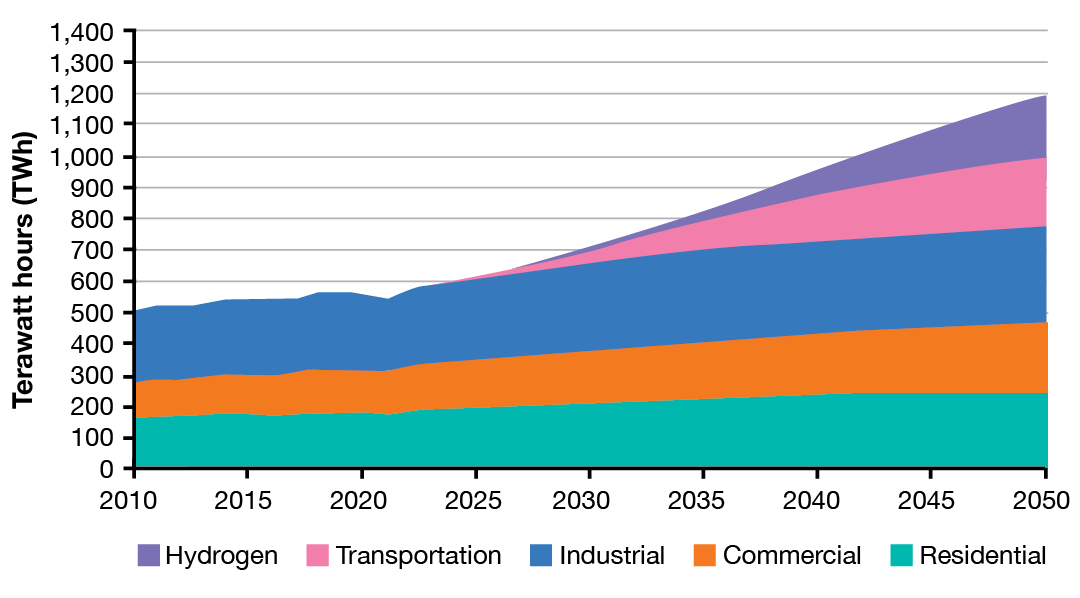
Chart summary and data
This stacked area chart shows projected electricity demand in the Global Net-zero Scenario in the residential, commercial, industrial, transportation, and hydrogen sectors.
Electricity demand grows steadily in the residential, commercial, and industrial sectors. Transportation and hydrogen production, which are near zero in 2021 become major drivers of growth in the projection.
Electricity use by sector, Global Net-Zero Scenario
Table showing projected electricity demand in the Global Net-zero Scenario in the residential, commercial, industrial, transportation, and hydrogen sectors.
Year |
2010 |
2015 |
2020 |
2025 |
2030 |
2035 |
2040 |
2045 |
2050 |
|---|---|---|---|---|---|---|---|---|---|
Hydrogen (Mt) |
0 |
0 |
0 |
0.13 |
1.01 |
2.46 |
4.3 |
6.3 |
8.01 |
Hydrogen (TWh) |
0 |
0 |
0 |
2.81 |
21.86 |
53.24 |
93.07 |
136.36 |
173.37 |
Residential |
159.50 |
170.35 |
176.88 |
193.27 |
204.54 |
216.45 |
227.19 |
234.92 |
240.35 |
Commercial |
126.24 |
139.32 |
144.83 |
164.42 |
180.20 |
197.96 |
213.66 |
224.94 |
233.90 |
Transportation |
0.99 |
1.21 |
1.03 |
7.45 |
40.58 |
92.42 |
145.21 |
184.72 |
214.21 |
Industrial |
224.42 |
225.32 |
230.199 |
246.70 |
269.39 |
281.34 |
287.68 |
301.64 |
326.36 |
Growing the Economy and Creating Middle-Class Jobs
A greater reliance on clean and non-emitting electricity can bring significant economic benefits and more jobs to a sector that already accounts for about $36.5 billion (1.8 percent) of Canada’s annual gross domestic product (GDP) and 100,000 jobs across the country. These employment numbers will only grow as investments in renewable energy tend to be more labour intensive than existing jobs in conventional energy sectors.Footnote 3 Footnote 4
Figure 2. Jobs per GWh for various generating technologies in CanadaFootnote 5
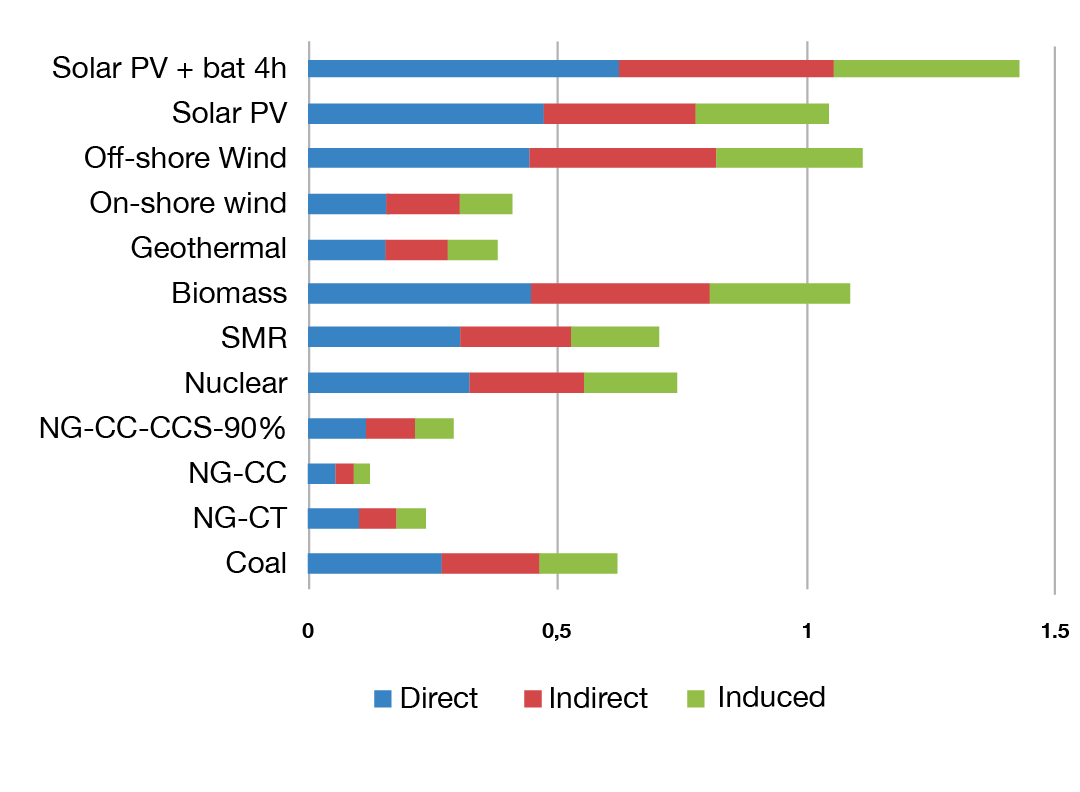
Chart summary and data
This graph showing the direct, indirect and induced jobs created per GWh of electricity from 12 different generation technologies. The highest is over 1 FTE/GWh of Solar PV + bat 4h and the lowest is NG-CC at close to 0.1 FTE/GWh.
Jobs per GWh for various generating technologies in Canada
Table showing the direct, indirect and induced jobs created per GWh of electricity from 12 different generation technologies.
Jobs created per GWh of electricity |
Coal |
NG-CT |
NG-CC |
NG-CC-CCS-90% |
Nuclear |
SMR |
Biomass |
Geothermal |
On-shore wind |
Off-shore Wind |
Solar PV |
Solar PV + bat 4h |
|---|---|---|---|---|---|---|---|---|---|---|---|---|
Direct |
0.15 |
0.05 |
0.03 |
0.07 |
0.20 |
0.18 |
0.30 |
0.115 |
0.12 |
0.35 |
0.31 |
0.43 |
Indirect |
0.12 |
0.04 |
0.02 |
0.05 |
0.15 |
0.14 |
0.25 |
0.09 |
0.11 |
0.30 |
0.21 |
0.31 |
Induced |
0.09 |
0.03 |
0.01 |
0.04 |
0.12 |
0.11 |
0.20 |
0.07 |
0.08 |
0.23 |
0.19 |
0.27 |
Alberta, for example, has already attracted $4 billion in new solar and wind investment since 2019, leading to the creation of an expected 5,000 jobs by the end of 2022Footnote 6.
As Canada moves towards net-zero, the need for qualified power sector workers has never been greater.
Figure 3. Jobs by electricity sector spending in Canada – 2020-2050 (total direct and indirect full-time employees)Footnote 7
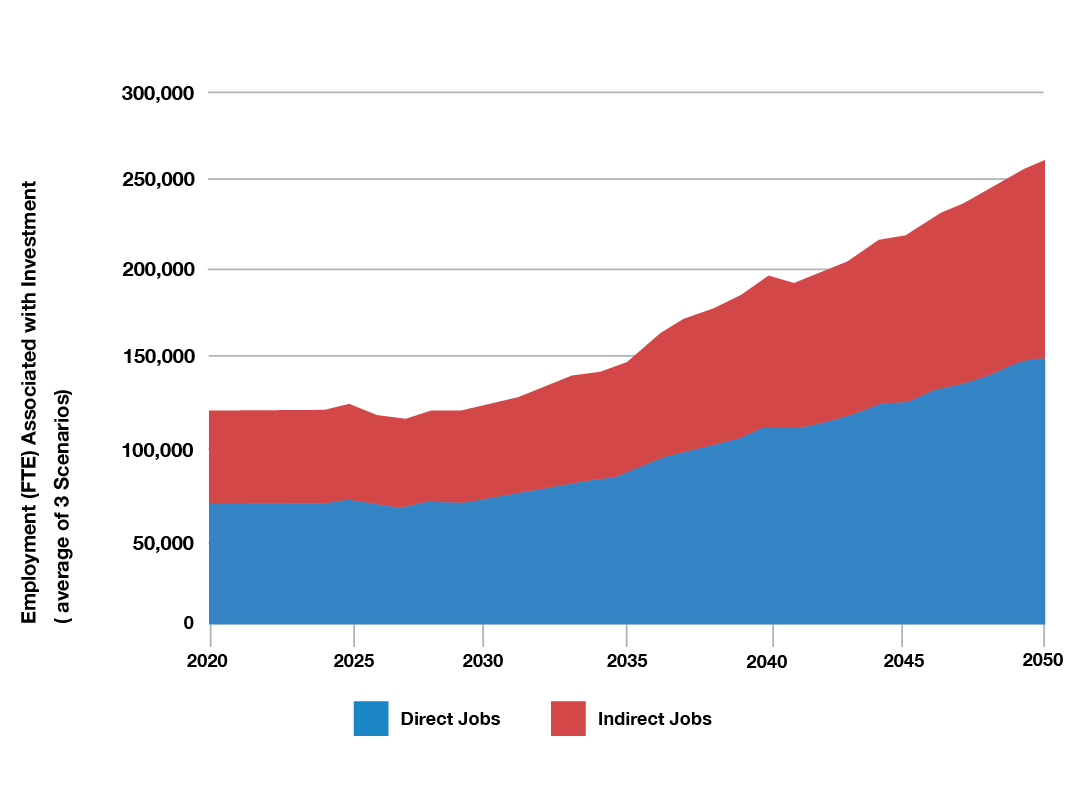
Text version
This stacked graph shows the projected indirect and direct jobs associated with electricity sector investment. It rises from around 125K in 2020 to over 250k by 2050.
The benefits of a clean electricity transition go beyond the jobs created within the electricity sector; the industries that rely on clean power will see an increase in employment as well. Canada’s electricity grid already plays a significant role in helping the country produce some of the cleanest commodities in the world, including steel, wood, fertilizer, cement, and minerals. Building on Canada’s low-carbon advantage and expanding the supply of clean electricity will position Canada to grow these industries alongside emerging sectors and attract other companies to locate their operations and manufacturing in Canada. A build-out of non-emitting electricity generation and the associated reinforcement and modernization of the grid will also increase direct employment in all parts of Canada.
Clean electricity is Canada's greatest competitive advantage in attracting investment—and we need more of it.
Making Life More Affordable by Enabling Energy Bill Savings
Canada already ranks third among developed nations for the lowest electricity rates for residential and industrial use. There is mounting evidence that deploying clean and non-emitting electricity would make energy consumption even more affordable for Canadians over the longer-termFootnote 8. But decarbonizing and expanding the grid will require a judicious mix of investments to ensure reliability, security, and competitiveness of supply in a way that can be achieved at the lowest long-term cost for ratepayers.
For example, a recent analysis by the Canadian Climate Institute (CCI) concludes that the average household’s spending on energy will decrease 12 percent by 2050 as Canadians switch from fossil fuels to more efficient technologies such as electric vehicles and heat pumpsFootnote 9.
Figure 4. Canadian household expenditures on energy 2025-2050Footnote 10
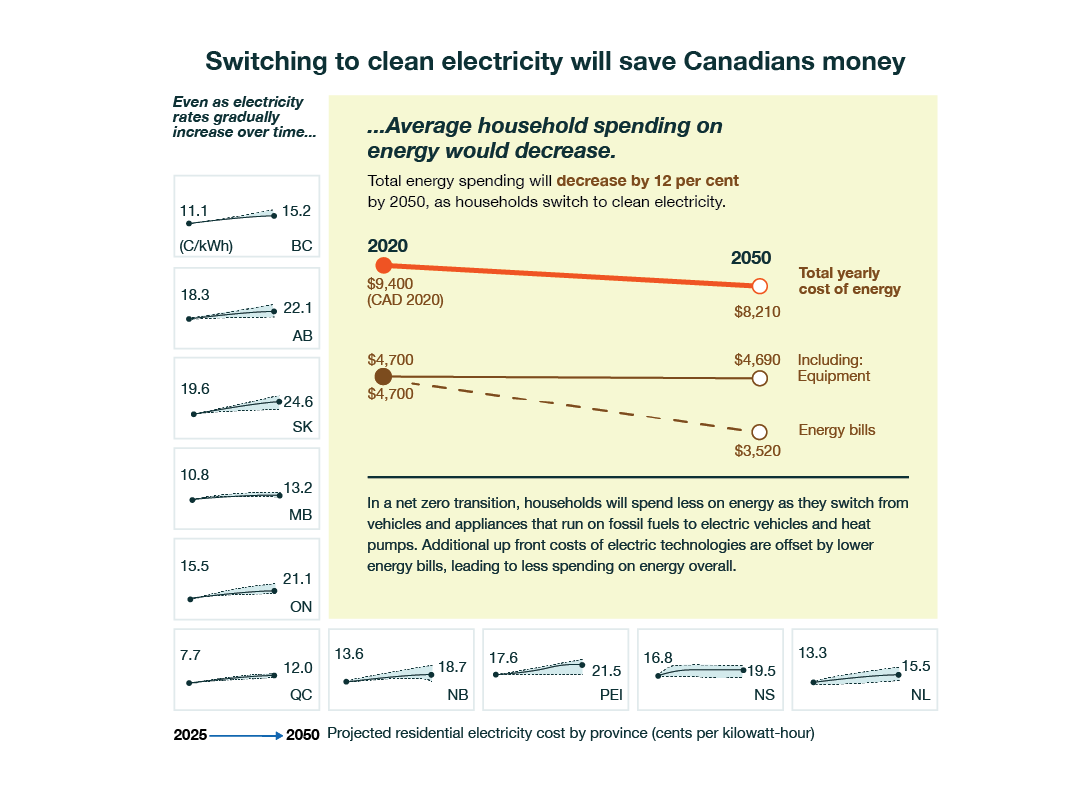
Text version
This Graph shows that the average Canadian household will spend 12% less on energy in 2050 compared to 2020 based on an analysis by the Canadian Climate Institute on the net zero transition.
As we make the ‘Big Switch’ to using clean & efficient electricity we know that energy expenditures will likely fall for Canadians.
As the past few years have demonstrated, global events can also have a major impact on the volatile price and availability of energy sources such as oil and natural gas. Renewable and non-emitting sources of energy, on the other hand, tend to be locally generated and less impacted by dramatic global price fluctuations. In addition, the cost of some renewable electricity deployments has been declining steadily over the past decade. Today, their capital costs are not only competitive with traditional electricity generation but expected to become even more attractive.
The Canada Energy Regulator, using a Global Net Zero scenario in its recent report, predicts that the capital costs for solar energy in 2050 will drop 62 percent below 2020 figures while wind will decline 14 percent over the same timeframe.
Despite this recent analysis, it must be acknowledged that not all potential savings are created equal. Capital costs and electricity rates will vary—sometimes substantially—from province to province and from territory to territory.
Enabling and Strengthening Indigenous Partnerships
As confirmed in a recent report by the First Nations Major Projects Coalition, Indigenous communities have been helping to drive the transformation of Canada’s electricity systems by building projects to supply clean electricity and reduce their reliance on fossil fuels in predominantly rural and remote communities. In turn, Indigenous communities are also reaping the economic benefits and new jobs that come with the development of these energy projects.
I am honoured and pleased to announce that we are celebrating the completion and energization of the 230 kV line to enable the connection of 17 remote First Nations to reliable, clean energy as mandated by our Chiefs and supported by our partners. This achievement took years of negotiations, perseverance and commitment by the First Nations, governments, and industry. This is a big step forward and a huge milestone towards fulfilling the vision.
The Government of Canada is supporting Indigenous-led clean energy projects and capacity building through programs such as the Smart Renewables and Electrification Pathways Program and the Clean Energy for Rural and Remote Communities Program. Through the Strengthened Climate Plan, the Government of Canada also established an inter-departmental initiative to improve access to funding and provide support for clean energy initiatives in Indigenous, rural and remote communities across Canada. Just earlier this year, this initiative was gifted the name Wah-ila-toos in recognition of the leadership role the Indigenous Council for Wah-ila-toos is taking to provide guidance and advice on program design and policy development. Also, the federal government provided $68.5M to support smart renewable energy projects partially owned by the Cowessess First Nation.
We need to see more investment into clean energy infrastructure that’s Indigenous-led, that deal with getting communities off diesel, and looking at some of the challenges related to technology in clean energy projects.
Delivering Clean Air, Climate Action, and a Healthy Future
Building net-zero electricity systems to power Canada’s economy also represents bold action to reduce greenhouse gas emissions, strengthen grid resiliency, improve air quality, and create a healthier environment that better protects our lands, waters, and biodiversity.
Burning fossil fuels such as unabated coal and natural gas, on the other hand, has negative impacts on human health and the natural environment—including increased air pollution. By phasing out unabated coal-powered generation units by 2030, Canada is expected to experience fewer premature deaths, fewer asthmatic episodes, and fewer air-quality advisoriesFootnote 11.
An independent assessment conducted by Toronto Public Health in 2014 suggests that improvements in Ontario’s air quality have translated into significant health benefits for Ontario residents. Toronto Public Health found that improvements in Toronto’s air quality from 2000 to 2011 have reduced air pollution-related premature deaths by 23% (from 1,700 to 1,300 per year) and hospital admissions by 41% (from 6,000 to 3,550 per year) in Toronto alone. It attributes the improvements in air quality to a variety of policies implemented by different levels of government including the phase-out of coal plants by Ontario (TPH, 2014).
Challenges Ahead
Transforming Canada’s energy systems will not be easy, and its impact will be felt in every facet of our daily lives. Among the biggest challenges will be those related to technical and regulatory barriers and economic repercussions:
Energy resources and technology availability: The ability of any province or territory to decarbonize its grid(s) will be constrained by numerous factors including its endowment of natural resources (e.g., hydro and wind), and the availability of new technologies. Availability of firm, dispatchable generating capacity (i.e., baseload electricity) can also significantly influence how much variable electricity—such as wind and solar—can be accommodated by a flexible grid and still produce reliable power as needed. There are many ways to address these challenges, including:
- new or enhanced inter- and intra-provincial transmission lines;
- new firm electricity capacity (e.g., large hydro, pumped hydro, or nuclear);
- increased stationary storage capacity (e.g., batteries, and other storage technologies);
- improved energy efficiency and productivity;
- advanced smart grid technologies; and
- demand-side energy resources including flexible loads and self-generation.
In addition, as provinces seek to increase domestic in-province/territory electricity production to support the decarbonization of the grid and the electrification of end-use demand, they will likely face a trade-off between supporting domestic net-zero economy goals and exporting surplus energy to U.S. markets.
Investment requirements and availability of skilled labour/supply chains: Decarbonizing Canada’s grids as domestic demand for electricity is poised to grow exponentially will be no small feat. It will require significant investments that could impact electricity rates and put added pressure on inflation-weary taxpayers and ratepayers alike. In addition, some jurisdictions are dealing with aging legacy infrastructure and/or an urgent need to modernize their grids, while facing limited fiscal capacity to do so without either cutting spending or passing on costs to ratepayers—all of which can exacerbate overall affordability issues in the short-term. Ongoing supply chain issues and availability of skilled labour and capital could also affect the best-laid plans.
Regulatory: Varying electricity regulatory and market structures create a myriad of hurdles that can slow the deployment of new clean electricity projects—particularly when they involve interprovincial infrastructure or joint planning. Provincial and territorial utility boards (i.e., economic regulators) typically have legislative mandates that focus on meeting near-term electricity demand and system reliability needs at the lowest cost to consumers. The significant value that long-term investments could have in facilitating regional trade, strengthening environmental performance, and driving long-term economic growth are not commonly factored into decision-making. Streamlining review and permitting processes along with modernizing regulatory and market structures to take advantage of new technologies and business models are essential to accelerate project development and implementation. More work must also be done to improve regulatory processes within the Government of Canada. Budget 2023 announced that, by the end of this year, for its part, the Government of Canada will outline a concrete plan to improve the efficiency of the impact assessment and permitting processes for major projects, including under the Impact Assessment Act, which will include clarifying and reducing timelines, and improving engagement and partnerships.
Again, pathways exist to enable provinces and territories to mitigate some of these challenges. Options include enhancing initiatives around energy efficiency and energy conservation; upgrading distribution grid capabilities and adopting distributed energy resources and microgrids; expanding electricity markets to become more participatory and to include new business models and participants, such as households; and incentivizing off-peak electricity consumption through advanced demand-side management (e.g., rewards to customers who shift consumption to off-peak periods). However, none of these measures taken alone is a magic bullet. They all require careful planning and consideration alongside significant capital investments.
It’s worth remembering, however, that the best energy is the energy we do not use. Improving energy efficiency and conservation are the most cost-effective ways to reduce energy bills, which means it is incumbent upon us all to prioritize gains in energy efficiency to defray some of the costs associated with building new and clean electricity resources.
Where we are now
Canada is starting from a position of strength with one of the cleanest electricity mixes in the world and a demonstrated ability to decarbonize its grids faster than many other countries. We’ve seen how quickly both Ontario and Alberta were able to act to get coal-fired power generation out of their electricity systems. However, achieving our goal of a net-zero electricity system by 2035, as well as a grid that provides affordable and competitive power that is also reliable, will require a concerted effort that includes significant ambition on the part of every province and territory; meaningful collaboration with Indigenous partners; and expert leadership from public utilities, industry, investors, unions and workers, and other key stakeholders. The Government of Canada is committed to use all the tools and policies at its disposal to support this energy transformation. This includes working with each jurisdiction—through such avenues as the Regional Energy and Resource Tables—to address their unique challenges and opportunities to build clean, reliable, and affordable electricity systems.
Figure 5. Canada’s total annual emissions from the Electricity Sector (2000-2020)
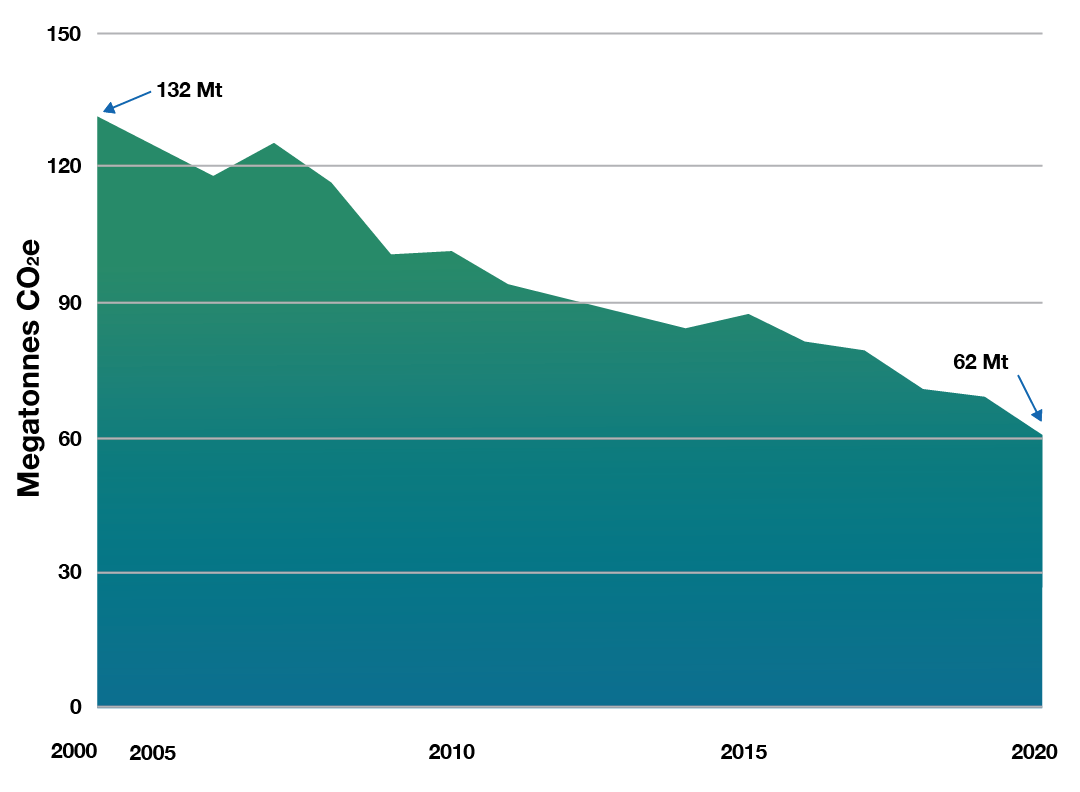
Text version
This graphic shows Canada's total annual emissions from the electricity sector. It begins at 132 Mt of CO2e in 2000 and gradually falls to 62 Mt CO2e by 2020.
Canada’s Electricity Mix
In 2020, the electricity sector produced 575 terawatt-hours (TWh) of electricity a year, which represented about 20 percent of the energy consumed annually in Canada.
Figure 6. Electricity Generation of Canada broken down by source
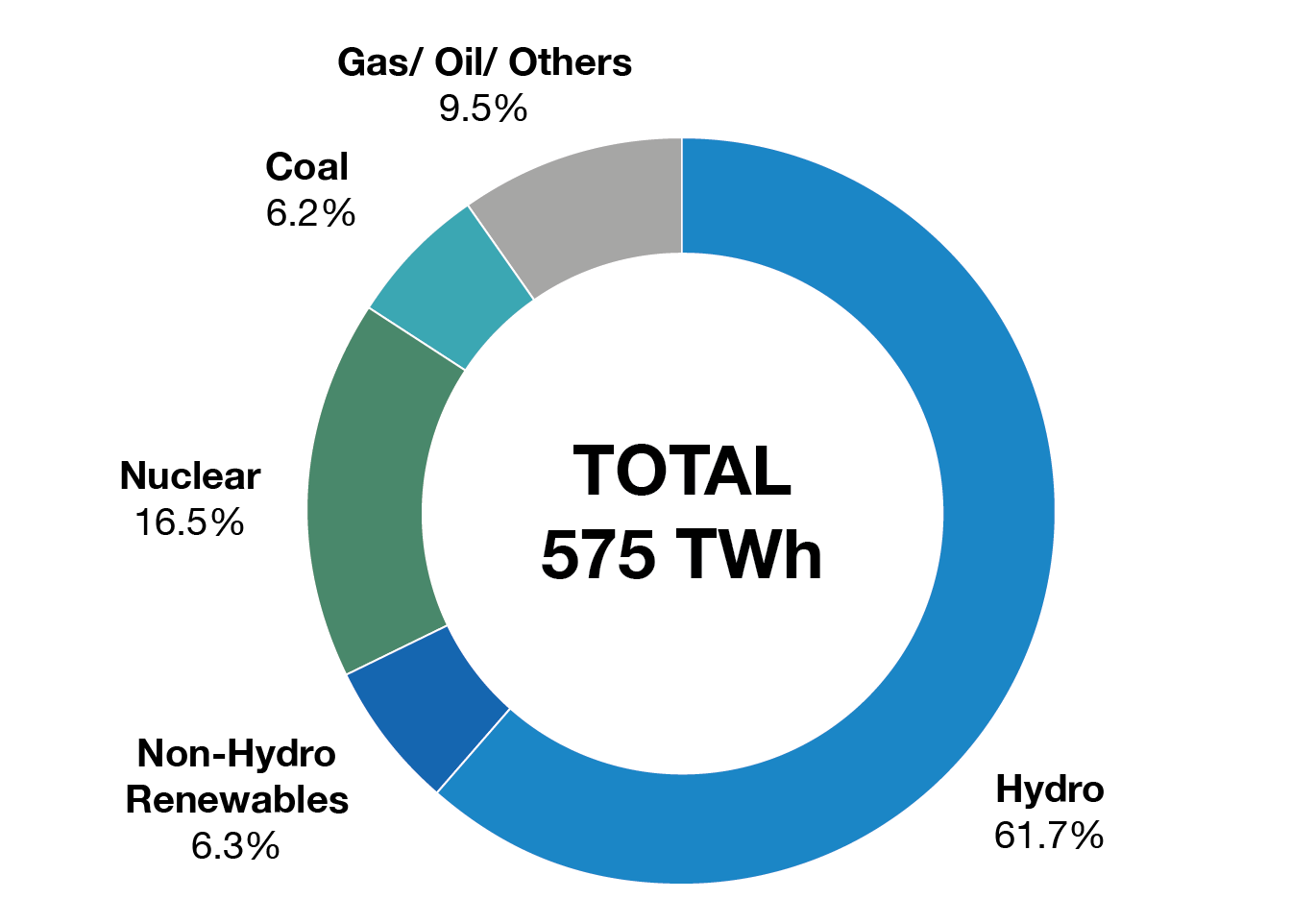
Text version
This graphic shows the Electricity Generation of Canada broken down by source: 61.7% from Hydro, 16.3% from Nuclear, 9.5% from Gas/oil/others, 6.3% from non-hydro Renewables, and 6,2% for coal.
Hydroelectricity accounts for about 60 percent of Canada’s electricity market. The remainder is produced from a variety of sources, including nuclear, wind, solar, natural gas, petroleum, biomass, and coal (Figure 2).
Electricity supply varies significantly across the country, as does the scale of the challenges to green and expand individual electricity systems.
Provinces such as Quebec, Manitoba, British Columbia, and Newfoundland and Labrador have vast hydroelectricity resources providing them with abundant clean energy and storage capabilities. Prince Edward Island’s electricity is also heavily drawn from renewable sources; almost all the electricity generated on the island comes from wind.
We can’t talk about our economic growth without talking about how we’re going to power that growth. Our government is strengthening Hydro to provide clean, green electricity for our growing economy, and we will ensure it is kept affordable for all Manitobans.
Ontario is Canada’s leading producer of nuclear energy but still relies on fossil fuels for some of its electricity generation. Other jurisdictions, including Alberta, New Brunswick, Nova Scotia, and Saskatchewan, are currently reliant on fossil fuels for much of their electricity generation. For Saskatchewan, Nova Scotia, and Alberta, grid decarbonization will be particularly challenging and may require them to work across jurisdictional boundaries. Fortunately, each of these provinces has an abundance of renewable energy resources and other non- or low-emitting options, whether it’s abated natural gas or nuclear. New Brunswick also uses nuclear energy and hydropower to provide a large share of its non-emitting power.
Finally, there are more than 200 remote communities across the country—most of them Indigenous—that currently rely exclusively or heavily on diesel generation for their electricity.
2020 GHG emissions in the electricity sector, total and by jurisdictionFootnote 12
Electricity total Greenhouse Gasses (Megatonnes), Total Generation (terawatt-hours), and Electricity Sector Emissions as a % of Total Emissions for every province and territory, and Canada as a whole.
Jurisdiction |
Electricity Total Greenhouse Gases (Megatonnes) |
Total Generation (terawatt-hours) |
Electricity Sector Emissions as a % of Total Emissions |
|---|---|---|---|
British Columbia |
0.4 |
58.4 |
1% |
Alberta |
32.7 |
55.8 |
13% |
Saskatchewan |
13.9 |
24.0 |
21% |
Manitoba |
0.0 |
37.2 |
0% |
Ontario |
3.7 |
149.0 |
2% |
Quebec |
0.3 |
188.0 |
0% |
New Brunswick |
3.5 |
12.0 |
28% |
Nova Scotia |
6.3 |
9.4 |
43% |
Prince Edward Island |
0.0 |
0.7 |
0% |
Newfoundland and Labrador |
1.0 |
39.8 |
10% |
Yukon |
0.1 |
0.5 |
9% |
Northwest Territories |
0.1 |
0.4 |
4% |
Nunavut |
0.2 |
0.2 |
25% |
Canada |
62.1 |
575.4 |
9% |
As Canada transitions to a net-zero grid, we must recognize parallel trends that will shape a net-zero electricity grid.
Progress in Decarbonizing Canada’s Electricity Systems
Canada has already made significant progress transforming its electricity sector.
As Canadians, we should be proud of our clean energy sector. It shows us that clean energy is a huge, growing part of our economy. It also shows us how much opportunity there is, and just how much we could lose if we try to stifle its growth. Clean energy isn’t on its way—it’s already here.
- Since the 1980s, Canada’s total electricity capacity has nearly doubled; in the past 10 years alone, capital investments in power infrastructure have averaged about $24 billion annually.
- The phasing out of coal-powered electricity generation has exceeded all expectations and regulatory requirements. For instance, while the original regulations in 2012 would have required the last coal-fired power plant in Alberta to be retired by 2061, the province is now on track to shutter the last such facility later this year. Combined with Ontario’s efforts, the two provinces are largely responsible for reducing Canada’s coal-related electricity emissions from 132 megatonnes (MT) in 2000 to 62 MT in 2020.
- Several electric utilities and power producers in Canada – including all the major ones in Alberta – have adopted net-zero emission targets. In 2021, with over 840 MW installed in one year, Alberta was the fastest-growing source of solar photovoltaic (PV) in Canada. There are also significant procurements planned in British Columbia and Quebec.
- Canada is a global leader in the development of Small Modular Reactors (SMRs), with Ontario Power Generation working to deploy as many as four grid-scale SMRs at its Darlington facility between 2029 and 2036. Both Saskatchewan and New Brunswick are also considering SMRs. In addition, Ontario is starting pre-development work at Bruce Power for up to 4,800 MW of new nuclear generation, the first large-scale nuclear build in three decades.
- Canada recently proposed amendments to the Canada – Nova Scotia Offshore Petroleum Resources Accord Implementation Act and the Canada-Newfoundland and Labrador Atlantic Accord Implementation Act to expand their mandates to include the regulation of offshore renewable energy.
- As of 2022, Canada had a total wind power and solar PV installed capacity of 17 gigawatts (GW). Utility-scale wind power accounted for the bulk of that figure with 14 GW.
- In 2020, Canada had over 81,300 MWFootnote 13 of hydro capacity, of which almost 90% were large hydro plants with reservoirs. These facilities can provide seasonal storage to help integrate larger shares of variable electricity, like wind power and solar power.
- Stationary energy storage is also beginning to be deployed in jurisdictions across Canada, including the recently announced Oneida Project and the procurement of seven new energy storage projects in Ontario to provide 739 MW of capacity as part of a larger commitment to install up to 2,500 MW.
At Energy Storage Canada we’re excited to see the IESO’s announcement of more than 700 MW of energy storage projects as the next step in Canada’s largest energy storage procurement to date.
What is the Federal role
Roles and responsibilities
Decisions about intra-provincial and territorial generation, transmission, and distribution of electricity in Canada fall under provincial and territorial jurisdiction. The provinces and territories are also responsible for electricity policy, market and regulatory structures, and electricity systems management and implementation.
Electricity regulation and market structures in Canada vary from a fully deregulated electricity market in Alberta to a hybrid market in Ontario, to regulated and vertically integrated markets in other provinces (the latter entails a single company that may own the generation, transmission, and distribution to deliver electricity to end users at regulated rates).
Municipalities and regional governments also play a role in the electricity sector as project developers who, in some cases, own and operate local distribution companies and handle municipal permitting processes.
The federal government has regulatory powers over interprovincial power lines, nuclear power, and electricity exports, as well as sharing jurisdiction over environmental regulations, such as carbon pricing and regulations to limit greenhouse gas emissions from power generation. Additionally, the federal government makes significant strategic investments in the electricity sector to achieve desired outcomes and objectives. The Government of Canada also has a convening role to facilitate collaboration, mobilize support and advance efforts related to specific objectives and regional needs, or to advance strategic policies with a national perspective.
Indigenous Peoples across the country have critical roles as rightsholders and clean energy leaders. Indigenous communities, governments, and organizations in every region of Canada have been active in developing electricity projects, and this trend is only expected to increase. Given the Government’s commitment to reconciliation and the implementation of the United Nations Declaration on the Rights of Indigenous Peoples (UNDRIP), the development and implementation of energy projects must be done in collaboration with Indigenous partners. Major energy projects have, in the past, led to negative impacts on Indigenous Peoples and territories over the years, including the fragmentation of hunting areas and the displacement of wildlife. Planning must be responsive to the priorities and realities of Indigenous communities, many of which are remote and rely on diesel for electricity generation.
Federal initiatives and vision
The Government of Canada is proposing to use all the tools at its disposal to support and collaborate with provinces and territories to build clean, affordable, and reliable electricity systems. These efforts can be grouped into four categories: convening and coordination; investment; regulation; and targeted policy.
1. Convening and Coordination
The federal government will leverage its convening power to help drive the pace of change and address the challenges we are facing in the transition to net-zero electricity. It will work in a collaborative fashion to bring together key partners, notably provincial and territorial governments, Indigenous partners, utilities, labour, and other relevant stakeholders to advance key infrastructure projects and the overall transformation of the electricity sector.
The Government of Canada has been taking an important convening and coordinating role to decarbonize and expand our electricity systems following the adoption of the Pan-Canadian Framework on Clean Growth and Climate Change (“the Pan-Canadian Framework”) in 2016. The Pan-Canadian Framework was Canada’s first national climate plan and includes a commitment by the provinces and territories to undertake specific actions in their respective electricity sectors, including:
- increasing renewable and non-emitting energy sources;
- connecting clean power with places that need it;
- committing to energy efficiency;
- modernizing electricity systems; and
- reducing their reliance on diesel by working with Indigenous Peoples and northern and remote communities.
To support the Pan-Canadian Framework, three distinctions-based senior bilateral tables (based on recognition of rights, co-operation, and partnership) were established in 2018 with the Assembly of First Nations, Inuit Tapiriit Kanatami, and the Métis National Council. These tables have built a structured, collaborative approach for ongoing engagement with Indigenous Peoples in the implementation of the framework and on broader Indigenous-specific clean growth and climate change priorities. The formats, approaches, and issues addressed under each table vary according to Indigenous Peoples' self-determined priorities.
Further leveraging its role as a convenor, the Government of Canada launched the Regional Energy and Resource Tables in 2022 to prioritize and advance net-zero growth opportunities across the country. Regional Tables have been launched jointly with nine jurisdictions so far: British Columbia, Manitoba, Ontario, New Brunswick, Nova Scotia, Prince Edward Island, and Newfoundland and Labrador, as well as the Northwest Territories and Yukon. Through the Regional Tables, the Government is also seeking to establish formal collaboration with Indigenous partners to identify and accelerate opportunities to transform Canada’s traditional resource industries and advance emerging ones. To support these efforts, the government has also been enlisting the expertise and insights of industry, unions, and workers, as well as other key stakeholders such as municipalities, electric utilities, and think tanks.
These Regional Tables complement discussions focused on strategic electricity infrastructure projects such as the Atlantic Loop, which would involve developing a more interconnected and resilient electricity grid in Atlantic Canada and Quebec. The Government of Canada has played a key role in convening the relevant parties to help achieve a clean power future for the region.
In May 2023, the Canada Electricity Advisory Council was launched as an independent body of 19 experts who will provide the Government of Canada with advice – through the Minister of Natural Resources – to help accelerate investments that promote sustainable, affordable and reliable electricity systems. The Council will prepare a report outlining its analysis and recommendations to the Minister at the end of its one-year term.
Canada is also working closely with international partners through the G7, G20, the International Energy Agency, the International Renewable Energy Agency and other global forums.
Canada and the United States launched a one-year Energy Transformation Task Force chaired by the U.S. Special Presidential Coordinator for Global Infrastructure and Canada’s Deputy Prime Minister to work across the spectrum of the clean economy. The task force will accelerate cooperation on critical clean energy opportunities and supply chains, including but not limited to, securing and strengthening renewable energy and electric vehicle supply chains, critical minerals and rare earths, grid integration and resilience, advanced and conventional nuclear energy and other areas that advance our collective energy security, and to avoid and reduce disruptions to our integrated and mutually supportive supply chains.
2. Investment
Budget 2023 announced an unprecedented made-in-Canada plan for a clean economy centred on three tiers of federal financial incentives to attract new investment, create good middle-class jobs, and build Canada’s clean economy: clear and predictable investment tax credits, low-cost financing, and targeted programming. Taking advantage of these measures would help provincial, territorial, and Indigenous partners to transform their electricality grids and open up new economic opportunities, while mitigating rate increases and ensuring electricity continues to be affordable.
With the investments made in Budget 2023, the Government of Canada has now committed more than $40 billion to support for Canada's clean electricity sector in the form of tax measures, public financing, and grants and contributions. These investments build on funding in previous recent budgets and will be delivered through a variety of federal departments, agencies, and Crown corporations.
Figure 7. Budget 2023: Canada’s Plan for a Clean Economy
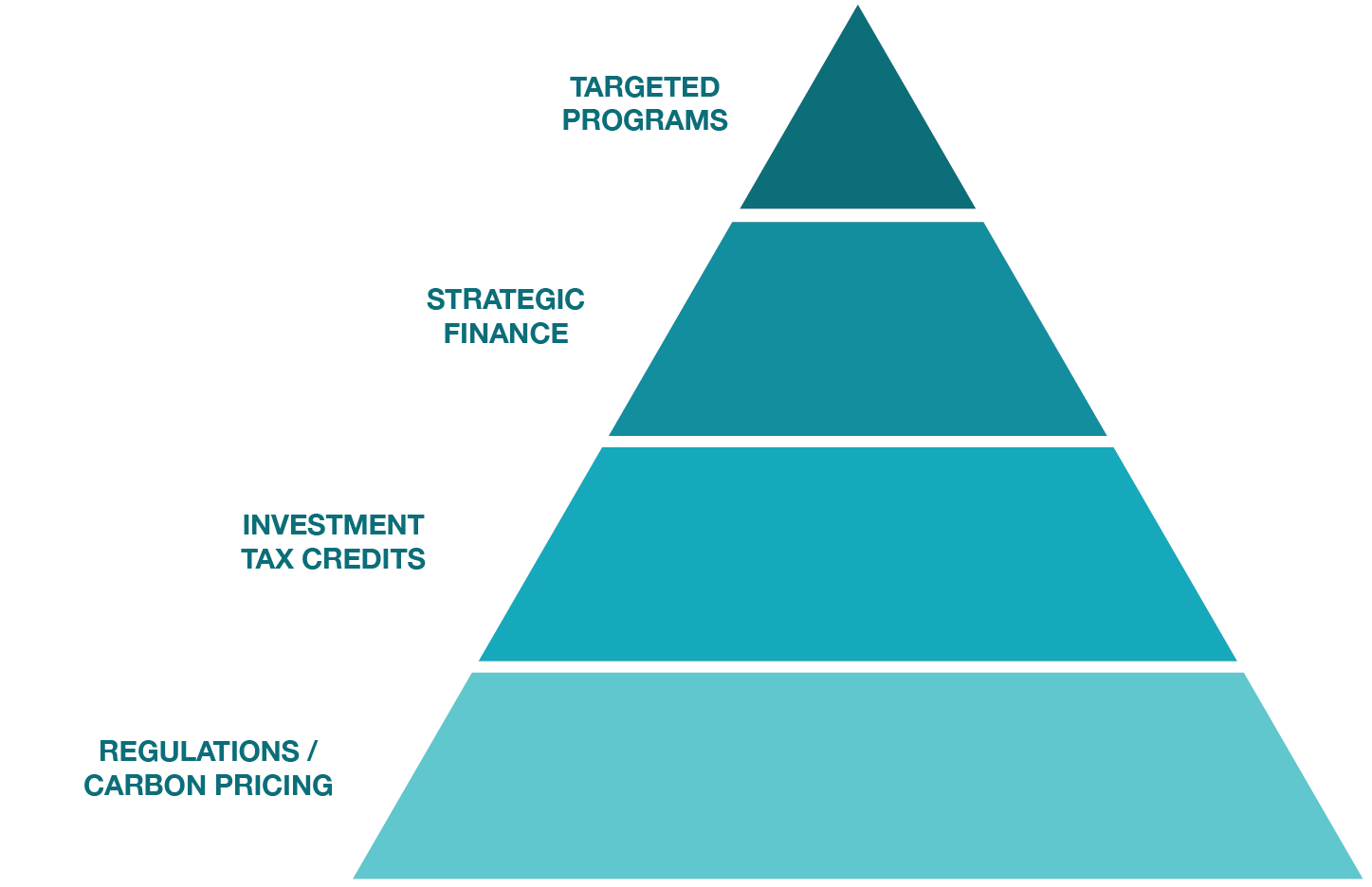
2.1 Targeted Programs
The Government of Canada has committed over $5 billion in grants and contributions for targeted clean electricity programs, with some funding extending for as much as 13 years, starting in 2023-2024. This includes:
- $1.5 billion for the Smart Renewables and Electrification Pathways Program (SREPs) – which has already committed funding to support 74 energy infrastructure projectsFootnote 14 totalling 2,750 MW of new, clean generation capacity, and 2,300 megawatt hours (MWh) of energy storage capacity – and nearly $3 billion in new funding in Budget 2023 to recapitalize this program. In addition, Budget 2023 provided an extension of the $100 million Smart Grid program and funding to promote offshore wind development.
- $250 million for the Clean Electricity Pre-development Program and $25 million for the Strategic Intertie Pre-development Program;
- Over $500 million to support diesel reduction, including for the Clean Energy for Indigenous, Rural and Remote Communities (CERRC) Program, which has supported 139 projects for renewable energy, capacity building, and related energy efficiency measures across Canada. The complementary Indigenous Off-Diesel Initiative provides clean energy training and funding for Indigenous-led climate solutions in remote Indigenous communities that currently use fossil fuels for heat and power and has supported 24 Indigenous Energy Champions to date.
The Strategic Innovation Fund—Net-Zero Accelerator is investing up to $8 billion in industrial transformation projects, decarbonization of large emitters, and clean technology and battery ecosystem development, many of which involve large-scale electrification.
The Low Carbon Economy Fund supports projects that help to reduce Canada’s greenhouse gas emissions, generate clean growth, build resilient communities, and create good jobs for Canadians. As announced in Canada’s 2030 Emissions Reduction Plan and Budget 2022, the Government of Canada committed to expanding the Low Carbon Economy Fund by investing an additional $2.2 billion over seven years, starting in 2022-2023. From this new funding, up to $250 million over four years will help homeowners transition from home heating oil to more affordable and greener home heating sources, such as electric heat pumps.
Launched in 2016, the Investing in Canada Infrastructure Program has made over $33 billion in federal investments available for a broad range of infrastructure assets in partnership with each province and territory. In April 2023, the Minister of Infrastructure and Communities announced the successful allocation of this program’s entire provincial funding envelope and that 5,400 projects having been approved under the program.
The federal government is already supporting several clean electricity projects including:
- Peak Smart Project in Yukon: Residential Demand Response Program: In 2018, Natural Resources Canada contributed over $700,000 to a project that used demand response technology to reduce the use of residential electric heating and hot water end-use loads when demand on the grid peaks in the winter.
- Burchill Wind Energy Project in New Brunswick: In May 2022, the Government of Canada announced nearly $50 million through the Smart Renewables and Electrification Pathways Program to support the Burchill Wind Energy Project, which is a partnership involving the Natural Forces and Tobique First Nation in New Brunswick. This project consists of 10 wind turbine generators, producing up to 42 megawatts (MW) of renewable energy, coupled with a utility-scale battery energy storage system.
- Métis Crossing Solar Project in Alberta: In August 2022, Natural Resources Canada announced an investment of nearly $9 million for the Métis Nation of Alberta to deploy a 4.86 MW solar power generation project in Smoky Lake County at Métis Crossing.
- The Deep Earth Energy geothermal facility in Saskatchewan: In January 2019, the Government of Canada provided $25.6 million in funding for the 5 MW facility, which will produce enough energy to power approximately 5,000 homes while eliminating yearly emissions equivalent to removing 7,400 cars from our roads.
2.2 Strategic Finance
The Canada Infrastructure Bank (CIB) was established in 2017 with the mandate to invest, as well as attract private and institutional investments, in revenue-generating infrastructure projects that are in the public interest. To support its mandate, the CIB has a $35 billion funding envelope. As announced in Budget 2023, the CIB will invest at least $10 billion in clean power projects (e.g. non-emitting generation, transmission lines, and storage projects,) and at least $10 billion in green infrastructure projects (e.g. green building retrofits and zero-emission vehicle charging and fueling infrastructure.) These investments will position the CIB as the government’s primary financing tool for supporting clean electricity projects. Budget 2023 further announced that the CIB will provide loans to Indigenous communities to support their purchase of equity stakes in infrastructure projects in which the CIB is also investing.
Examples of CIB recent investment in clean electricity projects:
- Darlington Small Modular Reactor (SMR) Project in Ontario: The 300MWe Darlington SMR project is being developed by Ontario Power Generation (OPG) in collaboration with GE-Hitachi, SNC-Lavalin, and Aecon Group. The project received a $970M loan from CIB to support the phase 1 development of the project. It will begin operations in 2028.
- Oneida Battery Storage Project in Ontario: The 250-megawatt (MW) Oneida Energy storage project is being developed in partnership with the Six Nations of the Grand River Development Corporation, Northland Power, NRStor, and Aecon Group. The project is receiving support from the Canada Infrastructure Bank as well as the Smart Renewables and Electrification Pathways Program, and it will begin operations in 2025.
2.3 Investment Tax Credits
Over the past two years, the Government has announced a suite of investment tax credits (ITCs) aimed specifically at accelerating investments in non-emitting electricity generation and delivery infrastructure. This federal financing, in an area of provincial/territorial jurisdiction, represents a fundamental departure and reflects the scale and importance of the challenge ahead.
A Greek company, Mytilineos Energy and Metals, is investing $1.7 billion to build five solar farms in Alberta. The company said it chose Canada because of its recently announced clean investment tax credits, and it settled upon Alberta, in part, because of its "streamlined permitting process" and stated goal of achieving 30 percent electricity production from renewables by 2030.
- Carbon, Capture, Utilization and Storage Investment Tax Credit (CCUS-ITC): In Budget 2022, the federal government announced a refundable 60 per cent credit rate for direct air capture, 50 per cent for capture equipment, and 37.5 per cent for transportation, storage and use design details of the CCUS-ITC - an important tool for reducing emissions in high-emitting sectors and helping to create good careers. Budget 2023 proposes additional changes to the CCUS-ITC that are expected to cost about $520 million over five years, beginning in 2023-2024.
- Clean Technology Investment Tax Credit (CT-ITC): In the 2022 Fall Economic Statement, the government proposed a refundable 30 percent CT-ITC for business investments in certain electricity generation equipment and stationary electricity storage, low-carbon heating, and non-road zero-emission vehicles and related charging and refuelling infrastructure. Budget 2023, further proposed to expand eligibility to geothermal energy. The expected cost of the CT-ITC is roughly $6.9 billion from 2023-2024 to 2027-2028.
- Clean Hydrogen ITC (CH-ITC): In the 2022 Fall Economic Statement, the federal government announced a refundable CH-ITC for investments made in clean hydrogen production based on the lifecycle carbon intensity of hydrogen. The levels of support will vary between 15 and 40 percent of eligible project costs, with the projects that produce the cleanest hydrogen receiving the highest levels of support. The proposed CH-ITC is expected to cost $5.6 billion over five years, beginning in 2023-2024. Between 2028-2029 and 2034-2035, the CH-ITC is expected to cost an additional $12.1 billion.
- Clean Electricity Investment Tax Credit (CE-ITC): To support and accelerate clean electricity investment in Canada, Budget 2023 proposed a 15 percent refundable CE‑ITC for eligible investments in certain non-emitting electricity generation systems; abated natural gas-fired electricity generation; stationary electricity storage systems; and equipment for the transmission of electricity between provinces and territories. Both taxable and non-taxable entities—such as Crown corporations and publicly owned utilities, corporations owned by Indigenous communities, and pension funds—would be eligible for the CE-ITC. The expected cost of the CE-ITC is roughly $6.3 billion from 2023–2024 to 2027–2028, and an additional $19.4 billion from 2028–2029 to 2034–2035. The design and implementation details regarding the CE-ITC, including conditions for eligibility, are still being developed.
Labour requirements—including the creation of apprenticeship training opportunities and wages that are paid at the prevailing level—will apply to both the CT-ITC and CE-ITC. - Clean Technology Manufacturing Investment Tax Credit (CTM-ITC): Budget 2023 proposed a refundable tax credit equal to 30 percent of the cost of investments in new machinery and equipment used to manufacture or process key clean technologies, and to extract, process, or recycle key critical minerals. The expected cost of the CM-ITC is roughly $4.5 billion from 2023-2024 to 2027-2028.
Today’s announcements are a strong and necessary step, accelerating our progress toward net zero. Canadian investment tax credits will stabilize investment opportunities, while safeguarding affordability for Canadians.
2.4 Supporting the Transition to net-zero Electricity
It is clear that provinces and territories will need to make very large investments in electricity generation and transmission over the next quarter century. Investments of more than $400 billionFootnote 15 are needed as part of both the routine replacement of aging facilities and the expansion of generation capacity to meet increased demands due to population and economic growth, as well as the switch to electric vehicles and electrified public transit, the adoption of electric heating in buildings, and the electrification of industrial processes. Making sure that the new power we bring online is clean will likely represent only a very small portion of the overall cost of the transition.
Recognizing the challenge and the importance of a successful transition to net-zero electricity, the Government of Canada has made unprecedented financial commitments to clean power. For provinces and territories, this partnering with the federal government shares the cost of the transition to clean power, providing an opportunity to significantly reduce the impact on rates from the transition to clean electricity, especially in Atlantic Canada and the Prairies.
The federal government is working to implement its new funding commitments in partnership with provinces and territories, and in a way that supports affordable net-zero electricity across Canada. The federal government will make these tools available to provinces and territories that take concrete action to achieve net zero. This includes demonstrating a commitment to use federal funding to lower electricity bills for households and businesses, and a commitment to achieve a net-zero electricity sector, which will apply to the Clean Electricity Investment Tax Credit and potentially to other federal instruments.
To ensure that these conditions are designed appropriately and reflect the reality of electricity systems across Canada, the federal government welcomes early engagement and discussion with provinces and territories, as well as other electricity system participants and experts, on access to federal support for clean electricity.
With respect to intra-provincial transmission, the government will consult on the best means, whether through the tax system or in other ways, of supporting and accelerating investments in projects that could be considered critical to meeting the 2035 net zero objective.
3. Regulation
Federal policy for Canada’s electricity sector is built around three clean electricity and climate-related objectives:
- transitioning off unabated coal-fired generation by 2030;
- achieving a net-zero electricity sector by 2035; and
- achieving net-zero emissions in Canada by 2050.
To drive progress toward Canada’s target of net-zero emissions by 2050 and building on the success of phasing out unabated coal by 2030, the proposed Clean Electricity Regulations send a clear regulatory signal that Canada is transitioning toward a net-zero electricity grid by 2035 to help drive investments in the sector. Ultimately with a view to increasing supply and availability of competitively-priced clean electricity across Canada.
Early, strong, and clear regulatory signals are needed to provide certainty to provinces and territories, investors, and utilities as they plan and operate their electricity systems for a net-zero future. This will ensure that decisions made now will enable Canada to meet its ambitious climate goals.
Electricity projects can take years to develop, and predictable regulations help manage risks associated with these lead times.
That is what the Government of Canada did when it introduced regulations to phase out unabated coal-fired electricity generation by 2030, and it has also implemented regulations to ensure that new natural gas-powered generation facilities improve their efficiencies. In December 2022, the Government published proposed regulations and requirements for light-duty vehicle manufacturers and importers to meet annual zero-emission vehicle (ZEV) sales targets that will result in 100% ZEV sales by 2035.
Last year, the Government of Canada launched engagement on the proposed Clean Electricity Regulations (CER) by publishing a Discussion Paper in March 2022 and the Proposed Regulatory Frame for the CER in July 2022.
The CER is being designed to accelerate the trend of decreasing emissions in the electricity sector and to create market signals to avoid new investments in high-emitting, unabated natural gas-powered electricity generation. The CER will require the gradual phase-out of existing unabated fossil fuel-based generators. To avoid stranding large capital assets and to enable continued access to affordable and reliable power, the CER will also provide flexibilities to allow the continued limited use of fossil fuel to generate electricity after 2035 during emergencies and to back up variable electricity.
The forthcoming publication of the proposed version of the CER in the Canada Gazette, Part I will start a 75-day public comment period and additional opportunities for engagement on the draft regulations to ensure they support a realistic pathway to clean, affordable, and reliable electricity that will be the backbone of a decarbonized economy. Following this further engagement with stakeholders, any requested comments, including requested changes, will be considered in the development of final regulations. Following this engagement, the Government will publish the final CER, which will come into force on a date to be set out in the Regulations.
Comparable regulations are being proposed in the United States. In March 2023, President Biden and Prime Minister Trudeau reaffirmed the commitment from both countries to achieve a net-zero power grid by 2035. The U.S. Environmental Protection Agency’s (EPA) proposed rules to regulate greenhouse gas emissions from fossil-fuel power plants requires coal and high-usage gas plants to capture 90% of their carbon, co-fire with cleaner fuels like green hydrogen, or shut down by the 2030s. The EPA indicated that the rules would put the U.S. electricity sector on track to meet the Biden administration’s goal of achieving a carbon pollution-free power sector by 2035.
4. Targeted Policy
The transition to net-zero electricity systems will boost Canada’s strategic advantage and enhance its reputation globally as a clean energy leader. There are significant opportunities in this fast-growing multi-trillion-dollar global industry, but there is also steepening competition and a need to build public and consumer confidence regarding costs and convenience.
The Government of Canada continues to show leadership by developing cross-sectoral, targeted strategies and initiatives to build a net-zero electricity system and a low-carbon economy.
Building on the Pan-Canadian Framework, the Government of Canada published Canada’s Strengthened Climate Plan: A Healthy Environment and a Healthy Economy in 2020. It also passed the Canadian Net-Zero Emissions Accountability Act in 2021, and presented Canada’s 2030 Emissions Reduction Plan: Clean Air, Strong Economy in 2022. In addition, it established the Net-Zero Advisory Body (NZAB) in 2021 to provide the Minister of Environment and Climate Change with independent, expert advice on pathways to help Canada achieve its climate targets. The NZAB released its first report in 2023, and it includes a line of inquiry on net-zero energy systems with specific recommendations for the electricity sector.
The Government also continues to show leadership by developing and implementing strategies that support the clean electricity transformation. On economy-wide climate action, this includes the National Adaptation Strategy and the Greening Government Strategy. Sector-specific strategies that assist in the promotion of a net-zero electricity grid include Canada’s SMR Action Plan, the Hydrogen Strategy for Canada, and Canada’s Critical Minerals Strategy.
What’s next
Electricity systems across Canada face different circumstances and opportunities. Recognizing that there is no one-size-fits-all approach, the federal government is keen to have ongoing dialogues with local, regional, provincial, and territorial governments, as well as other electricity system participants and experts, to chart individual ways forward.
Feedback from this dialogue will help inform the Government of Canada’s planned Clean Electricity Strategy, which is expected to be published in 2024. The Strategy will also draw on information collected through various engagement and consultation processes targeting the electricity sector (refer to details below). It will lay out the integrated package of policies, tools and actions that the Government plans to use to support, facilitate and accelerate the electricity sector’s transition to net-zero while ensuring Canada’s clean energy future reflects and builds upon unique circumstances and opportunities emerging in different parts of the country.
Engagement and Consultation
The recently appointed Canada Electricity Advisory Council is focusing on several key areas to support its independent, expert advice to the Government for creating a net-zero emitting electricity system by 2035, and through it, a net-zero emitting economy by 2050. This includes studying and advising government on any additional steps to ensure the transition is affordable for Canadians; how to enable the pace of investment and project development needed; how to ensure Indigenous communities can take part in- and benefit from those investments; how to facilitate regional cooperation where beneficial; and how to accelerate innovation to ensure affordability, reliability and value growth far into the future. The Council will provide its advice in a final report in 2024 and may provide interim advice to the Government along the way. Its advice will be a key contributor to the federal strategy. To learn more, contact the Council Secretariat at ceac-ccce@nrcan-rncan.gc.ca.
Over the coming months, the Government will also be engaging Canadians through several tracks for engagement and consultation, including:
- Targeted engagement with Provinces, Territories, and Indigenous communities, including through mechanisms such as the Regional Energy and Resource Tables, federal-provincial working groups, and the distinctions-based tables based on recognition of rights, co-operation, and partnership with First Nations people, Inuit, and Métis, as part of the Pan-Canadian Framework for Clean Growth and Climate Change.
- Finance Canada is engaging with provinces, territories, and other relevant parties to develop the design and implementation details of the Clean Electricity Investment Tax Credit that was announced in Budget 2023. To share your views on this tax credit, contact cleangrowthITC-CIIcroissancepropre@fin.gc.ca.
- Environment and Climate Change Canada will soon publish proposed Clean Electricity Regulations in the Canada Gazette, Part I. The Government of Canada is committed to ongoing engagement with provinces, territories, and stakeholders to ensure the Regulations are as well designed as possible. Once published, the start of a Canada-wide 75-day consultation process on the proposed Regulations will begin.
- Natural Resources Canada is seeking views on the design of its recapitalized clean electricity programs, including the Smart Grids Program and the Smart Renewables and Electrification Pathways Program (SREPs). The design of the recapitalized SREPs is meant to ensure that it is complementary to the other new measures announced in Budget 2023, in particular the investment tax credits. Natural Resources Canada will also be seeking views on how the federal government can best support intra-provincial transmission lines. To learn more and share your views, contact Sreps-erite@nrcan-rncan.gc.ca. The Smart Grid Program and Innovation & Electricity Regulation Initiative are intended to better support innovation to accelerate pathways to scale in the provincial and territorial energy regulatory context. To learn more and share your views, contact sg-ri@nrcan-rncan.gc.ca.
Making Canada’s grid:

Cleaner — Decarbonizing the grid by building non-emitting supply, attracting investment, improving energy efficiency, and reducing the reliance of rural, remote, and Indigenous communities on diesel.

Affordable — Keeping the cost of electricity competitively priced, affordable and accessible for Canadians in all regions

Reliable — Ensuring adequate supply to meet growing demand; improving resiliency to climate impacts, and protect vital infrastructure from cybersecurity threats.
Conclusion
Around the world, communities, businesses large and small, Indigenous Peoples, unions, and governments are in a race to reduce carbon emissions, seize extraordinary economic opportunities, and avoid the destructive impacts of climate change. The smartest money, in search of long-term gains, is steering away from assets that will perform poorly in a low-carbon world.
Canadians understand that it is up to us as a country to come together and collaboratively decide on the best ways to build a thriving, sustainable net-zero future. After all, Canada has always worked best when Canadians work together. We have a history of meeting big challenges. We saw that spirit in the building of a railway that spanned the continent, a broadcasting system that connected a country, and an arm that reached into space.
Decarbonizing our electricity systems and electrifying our economy are our moonshot for the 21st century. It will require all levels of governments rallying together in common cause with Indigenous partners, public utilities and private investors, industry and labour, environmental organizations, and civil society. By working together on a shared vision, we can deliver the clean, reliable, and affordable grids that will sustainably power our homes and communities, create good, middle-class jobs, and ensure a future that our children and grandchildren can inherit with pride and build upon with confidence.
For more information about this document, to submit your views on clean electricity in your region, or to provide input on the Clean Electricity Strategy for Canada, please contact Natural Resources Canada at: Cleanelectricitystrategy-Strategieelectricitepropre@nrcan-rncan.gc.ca.
